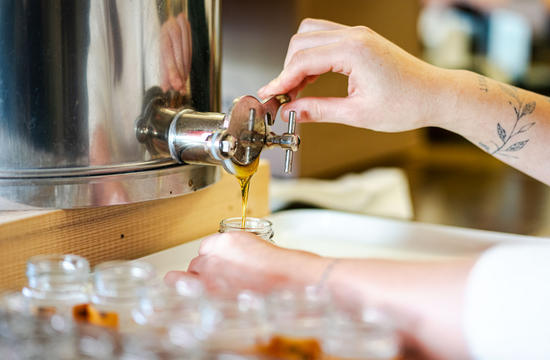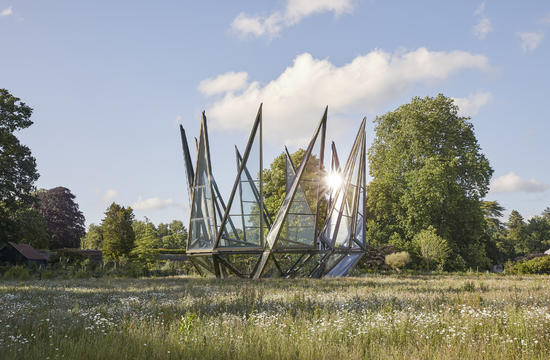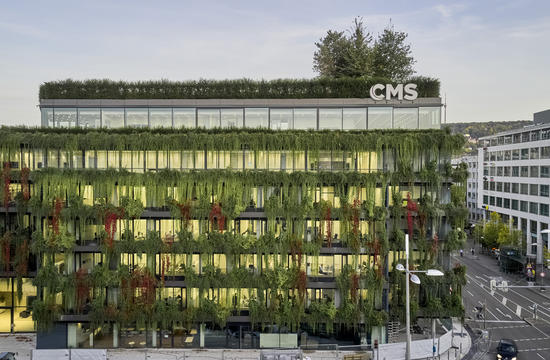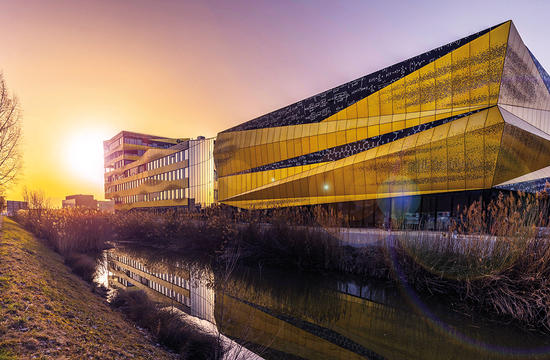Kaiser Beckenbauer’s master builders
Text: Lars Thieleke
„Old Boys“ encounter with the champion record-holder: Architect Tom Ferster, site manager Christoph Eisenhut and RAICO founder Albert Inninger take a tour of the FC Bayern München ground and recall their joint construction projects at the Säbener Strasse. They explain what all the fuss with the “church window” and “Kahn gob” was about, and what Kaiser Beckenbauer thought of it all. Starting point: the famous entrance side of the building.
Tom Ferster: It still looks good, doesn’t it? This is where it all began. How long has it been now?
Christoph Eisenhut: It was in 1989 when we put up the curved glass curtain walling and rebuilt the administration building.
Albert Inninger: That’s right. I still remember setting up my own Bayern-Munich fan club a couple of years before. We wanted it to be a proper fan club, not just a bunch of rowdy noise-makers. Uli Hoeness (now the club’s chairman) liked what he saw. That’s how I got to know him and how I found out, during a Christmas party, about the planned rebuilding work and invitation to tender. I really wanted to get the project. Actually working for FC Bayern was just the best thing that could happen, so I was on cloud nine when I finally won the tender and got the contract.

Tom Ferster: Things were quite relaxed at our end. Each architect was asked to supply a draft design of how they thought the entrance side of the building should look. So I took along a sketch and showed it to Franz Beckenbauer, Fritz Scherer, Kurt Hegerich and vice-chairman Hans Schiefele. Fritz Scherer took a look at my curved design and said: “It looks like one of the beer tents at the Oktoberfest.” It came to be known as the “church window” for short. Most of the other architects had drawn rectangular boxes, as I recall. I wanted to do something different, to get a conversation going.
Albert Inninger: So was it for that reason that your design was curved, and not boxy?

Tom Ferster: It was all because of the excitement of football, which I wanted to translate into the outline of the building. And I wanted to use it as a frame for the FCB emblem. It occurred to me, when sitting at the drafting table, that the Bayern-Munich emblem is actually rather beautiful, one of the most beautiful of any football club in fact. Thus began several years of cooperation with FC Bayern. I controlled the artistic side of many projects, while Christoph dealt with site management. And you, Albert, supplied the things we needed.
Albert Inninger: I’ll never forget what happened the day the glass structure arrived on site. The fitter lifted it up,
and said: “Something’s not quite right here”. Then it suddenly dawned on me: The rows of diamonds in the middle of the emblem didn’t run from bottom left to top right, but the other way round!
Christoph Eisenhut: I didn’t know that.
Albert Inninger: I thought “Thank God I found that out before the tabloids got their hands on it.” The misbegotten emblem is still there in my basement. I might set it up in my conservatory one of these days.

Tom Ferster: It should have official protection. Well I remember when we demolished the changing room where Franz
Beckenbauer used to shower after training in his playing days. Now that should have been made a protected building.
Christoph Eisenhut: And your castle loopholes too.
Tom Ferster: You mean those really small windows?
Christoph Eisenhut: They’re the ones. I’ve always asked myself that: Why did you go for those loophole things, rather than proper windows?
Tom Ferster: I wanted the admin building and the training centre to form a single unit based on a shared look. And the part for the professionals, where the players get changed and take their communal baths, needed to have its own enclosed character. Hence the loophole-like windows, to prevent the paparazzi from getting a look in.
Christoph Eisenhut: We travelled as far afield as Eindhoven and even England in those days, to get an impression of other training grounds. But they were all attached to their respective stadiums, not separate premises like at
FC Bayern.
Tom Ferster: I also remember drawing up the designs for the carpenter who made the first cupboards for the changing room. I spoke to the facility manager about it, and he said: “You need to make the tops of the cupboards slant, so the players won’t leave their dirty underpants on top.” And that’s what I did. The caretaker also insisted on a master key for the lockers, and asked me not to fit just combination locks, but ones that could be overridden with a key. He foresaw players coming up to him, after every second training session, with “I can’t get my locker open. I’ve forgotten the combination.”
Albert Inninger: That’s not serious!
Tom Ferster: Tell me about it. We even considered which way the players would take when coming in after training. Up to this day, they tend to leave a trail of dirty washing on their way to the chutes; one for strip, one for boots. And when player Lothar Matthäus came up to his locker, there would be a freshly laundered bathrobe waiting for him. But I think things are different nowadays.
Christoph Eisenhut: What do you mean by “nowadays”? Well our building job made a lot of difference. The original plan was to incorporate a kind of common room into the professionals’ area, with restaurant facilities, to welcome Real Madrid during the European championship games. And there was also to be a small shop, occupying about 20 m², with a stock of scarves and woolly hats. But even before the dining area was finished, the retail space had become so big that the restaurant had to be torn out again. And when you consider that nowadays everything takes place in a service centre occupying around 500 m² …
Tom Ferster: True. The rebuilding work seemed to go on forever. There were always new ideas to consider in those days whenever a new manager, such as Jürgen Klinsmann, came along. Haven’t you got one of the team strips from his playing days in your collection, Albert?
Albert Inninger: I’ve got two or three from each season of the last 30 years, but none belonging to Jürgen Klinsmann.
I always managed to get a strip off Franck Ribery in the last few years. He’s my absolute favourite player.
Christoph Eisenhut: Were you there the day they laid the foundation stone of our project, and at the topping-off ceremonies for the entrance side and the admin building? Players Manni Schwabl and Radmilo Mihajlovic were both there. And so was Jupp Heynckes, of course. He was the manager at the time.

Tom Ferster: I always found Jupp Heynckes to be a really friendly and modest man.
Christoph Eisenhut: Absolutely. And I will never forget Klaus Augenthaler; an absolute one-off. People of his calibre are unfortunately increasingly rare nowadays.
Tom Ferster: Things are completely different today. Even for advanced ticket sales, as it’s all done online nowadays.
Christoph Eisenhut: Advanced ticket sales was in the old building at 51, Säbener Strasse in those days, on the first floor. If a European Cup match was coming up, the queue would stretch all the way down the staircase and into the street. Whenever we needed to get into the upper storey of the admin building, we had to elbow our way through the queues, and we got some really dirty looks, because people thought we were trying to push in.
Albert Inninger: You did rebuilding work while they were selling tickets?
Christoph Eisenhut: We almost needed a battering ram to get up the staircase! But we weren’t allowed to carry out noisy work during the normal office hours of FC Bayern. We could only really let rip between six and nine in the morning and four and ten at night. And just as we were getting proud of the progress we were making under the circumstances, Franz Beckenbauer came back from New York and said: “So how long do you still need to get is extra floor done? They manage a complete skyscraper in New York in the time that you’re taking.” Kaiser B was always friendly and ready with a joke, and great to have around.

Albert Inninger: This is just unreal! But those were special circumstances.
Tom Ferster: You worked quite closely with Albert during these building projects, didn’t you, Christoph?
Christoph Eisenhut: Albert had my back. Whenever problems arose, he made sure they weren’t passed on to me. Just take logistics. Getting that glass panel shifted into place without a crane was all down to him. There are others you need to be constantly on top of, if you want to get anything done. You could always rely absolutely on Albert. And he was always available for me, even when he couldn’t be reached personally or wasn’t on duty. He always gave me good advice. A good man to have on hand on the site.
Tom Ferster: We already knew each other, but we didn’t get to know Albert until we started the first project for FC Bayern.
Christoph Eisenhut: Exactly. He was already a world champion when it came to curtain walling, while we were still relatively new to the game. We had some intense discussions, and I was really pleased to be working with a highly competent and reliable partner who was also closely connected to FC Bayern. We talked about football all the time.

Tom Ferster: It’s best to go to the Olympic Stadium together. We had VIP invitations, and Albert had his season ticket. We managed to enjoy a beer together at almost every game.
Christoph Eisenhut: He didn’t want to disappoint his FC Bayern, and we naturally wanted to have people like him onside.
Albert Inninger: It really was a personal mission for all of us. But you two did a lot more. In fact, I wasn’t really needed for some of the rebuilding work.
Tom Ferster: Do you know the "Kahn Gob"?
Albert Inninger: Pray tell me what a “Kahn Gob” is.
Christoph Eisenhut: We were supposed to build a 300-space underground garage beneath the training grounds. How do you go about draining a ground, without the grass rotting or growing fungus, if there is an underground car park below it? You can’t really put a big drain down the middle of the pitch!
Tom Ferster: To let even pouring rain flow away, we used a sloping concrete roof, designed in the form of a funnel leading to a large two-metre-diameter storm drain buried under the ground. The drain takes the water through the underground garage and into the surrounding earth.
Christoph Eisenhut: My lads started moaning, as each section had to be put in at a different height, measured to the exact centimetre. We also eliminated some of the spaces in the underground car park and filled them with gravel, so that water from the pitch could drain straight down into the soil.

Tom Ferster: That’s why we installed the "Kahn Gob". The underground car park needed an emergency exit. The staircase would normally come straight up to a door opening onto the grass. But we naturally couldn’t do this on a football pitch that was being played on. The German Football Association also had specifications about how far the staircase should be from the door and the touchline of the pitch. But emergency exits also have to conform to a maximum length. This is why we incorporated a trapdoor into the pitch, to allow the gate to open straight out onto the grass.
Christoph Eisenhut: The trapdoor is no longer there. I would really have loved to see the face of someone who came up through it to stand face-to-face with Oliver Kahn. Who knows, maybe he would have turn the other way round immediately …
Stern des Südens: Fassadensystem RAICOTHERM A 50.
The steel roof with its famous aluminium curtain wall still stands proudly above the entrance to the centre of all things Bayern Munich. The curtain wall system is an A50 model of the first THERM generation, although it shares all the same basic construction principles of the present-day RAICO THERM+ System. It has been optimised over the years since its launch in 2004, with improved performance in areas such as heat insulation and noise protection. But then RAICO Systems have always tended to go well beyond the legal requirements of both then and now.





